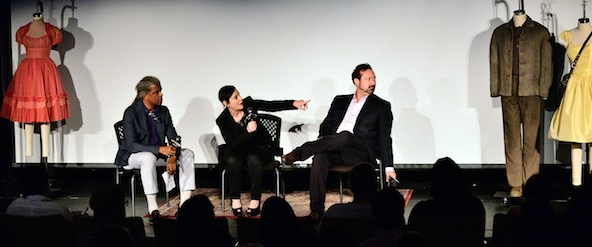Creating Character with Costume Design—Arianne Phillips Shares Her Secrets

There’s something inspiring about two extremely accomplished creative types who say the secret to their success is being open to the other’s ideas.
When director James Mangold and his frequent costume designer Arianne Phillips sat down with Film Independent curator Elvis Mitchell at the Los Angeles Film Festival earlier this summer for the Costume Builds Character Costume Design Master Class, they made it clear that the strength of their relationship is based on valuing the other’s point of view and being open to what any given moment presents.
“Every film has its own needs. I never want to go in saying, I’m an expert,” Phillips said. “I go in saying, ‘let’s have a conversation.” That’s the reason filmmaking is called a journey, she pointed out: It’s about the discoveries you make along the way.
“You can’t know it,” agreed director James Mangold, who has worked with Phillips on Girl Interrupted, Walk the Line, Knight and Day and 3:10 to Yuma. “No one can ever know it. Stuff’s going to happen.” The two share the belief that the vagaries of the location and ideas and feelings of the actor should play a significant role in the creative process. For instance, when Russell Crowe was cast as an outlaw in 3:10 to Yuma, Phillips initially envisioned him in a slim, fitted white leather jacket inspired by one she’d seen in the Roy Rogers Museum. “A white leather jacket isn’t something Russell Crowe wanted to entertain,” she said. Ben Foster, who plays a ruthless bounty hunter in the film, ended up in the jacket—a decision Mangold and Phillips both in hindsight say was the right one. (Crowe wore a roomier black coat.)
“You have to be sensitive to what the actor brings,” Phillips said.
Mangold praised Phillips’ reassuring manner when she’s working with actors, particularly during the initial fitting. “The costumers are like the advance team in the process of the actor,” Mangold said.
“When you talk to actors,” Phillips said, “they’re never really comfortable.”
Because the wardrobe department plays a pivotal role in the actor’s initial discovery of the character, the relationship between the director and costume designer is a crucial one—and ideally is based on trust. Mangold said that it’s about having trust in his costume designer not only in handling what the actor will wear, but handling their first journey into the movie. “That first meeting with wardrobe is an opportunity for the actor to get information,” he said—which is why it is critical for the costume designer and the director to be in sync.
For period pieces, Phillips and her team does painstaking research, but she doesn’t insist on authenticity just for authenticity’s sake. “Just because it existed, doesn’t mean it has value for what we’re doing,” she said. “I do want to know everything and then I can figure out what has value to us.”
“Every movie is a science fiction film,” Mangold pointed out. “Yuma is a big wet dream of American history. The whole Western genre is based on historic events in the US that only lasted six months.”
The costumer’s goal is to contribute imperceptibly to the audience’s experience of the story. “God forbid a costume should take someone out of the experience,” Phillips proclaimed. “When you notice a costume, there’s something wrong.”
Pamela Miller / Website & Grants Manager
